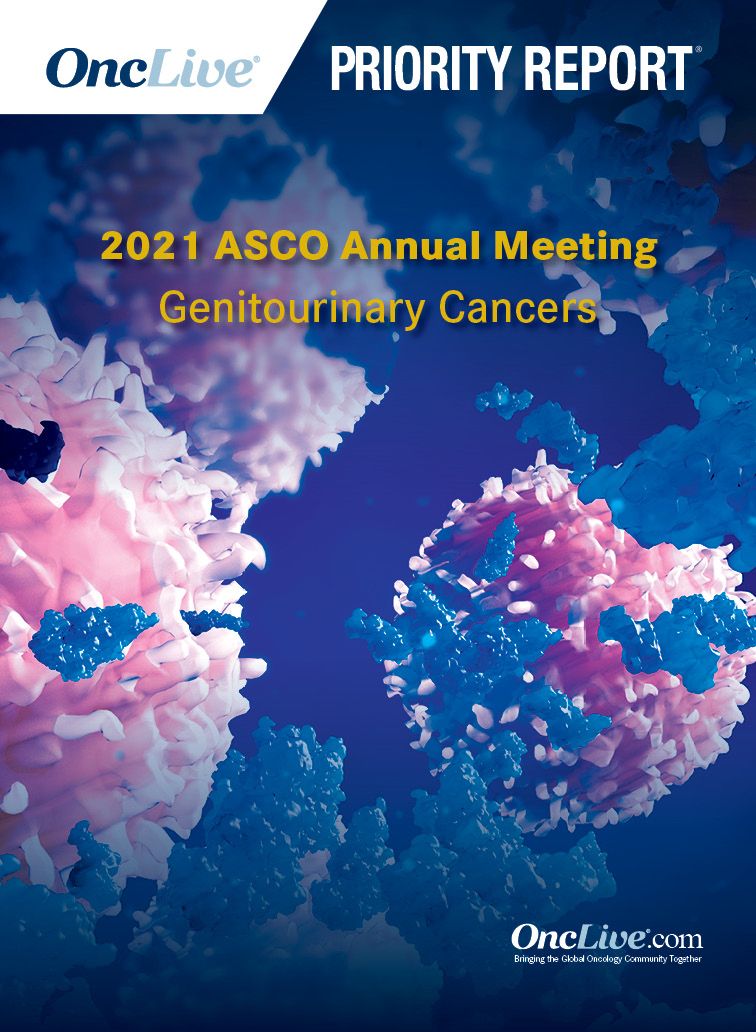Publication
Article
Supplements and Featured Publications
Cabozantinib Exposure Not Associated With PFS, But Is Linked With Higher AEs With Cabozantinib/Nivolumab in RCC
Author(s):
Cabozantinib exposure was not significantly associated with progression-free survival but appeared to predict high rates of palmar-plantar erythrodysesthesia and diarrhea in patients with advanced renal cell carcinoma treated with the frontline combination of cabozantinib and nivolumab.
Amishi Y. Shah, MD

Cabozantinib (Cabometyx) exposure was not significantly associated with progression-free survival (PFS) but appeared to predict high rates of palmar-plantar erythrodysesthesia (PPE) and diarrhea in patients with advanced renal cell carcinoma (RCC) treated with the frontline combination of cabozantinib and nivolumab (Opdivo), according to findings from an exposure-response (ER) analysis of the phase 3 CheckMate 9ER trial (NCT03141177) that was presented during the 2021 ASCO Annual Meeting.
“ER modeling predicts that appropriate dose modification of the 40-mg cabozantinib starting dose to manage AEs [adverse effects] will not adversely affect the efficacy of nivolumab plus cabozantinib in first-line advanced RCC,” lead study author Amishi Y. Shah, MD, an assistant professor in the Department of Genitourinary Medical Oncology at The University of Texas MD Anderson Cancer Center, and co-authors wrote in a poster of the data.
The CheckMate 9ER trial revealed that the frontline combination of nivolumab plus cabozantinib significantly improved PFS (HR, 0.51; 95% CI, 0.41-0.64; P < .001), overall survival (OS; HR, 0.60; 95% CI, 0.40-0.89; P = .001), and objective response rate (P < .001) compared with sunitinib (Sutent) in patients with advanced RCC.
In the study, patients with previously untreated RCC received 40 mg of cabozantinib daily in combination with 240 mg of nivolumab every 2 weeks.
The regimen was generally well tolerated among patients, with low rates of treatment-related discontinuations. Dose modifications appeared to successfully manage AEs and allow patients to tolerate the regimen.
Patients (n = 320) received a median average daily dose of 29.4 mg of cabozantinib in the CheckMate 9ER trial. First-level dose reductions of cabozantinib to 20 mg daily because of AEs were observed in 50% (n = 161) of patients after a median time of 98 days (range, 9-506). Second-level dose reductions of cabozantinib to 20 mg every 2 days were observed in 8.1% of patients (n = 26) after a median time of 173 days (range, 65-613).
Because of AEs, 7.5% of patients (n = 24) discontinued cabozantinib, 6.6% of patients (n = 21) discontinued nivolumab, and 5.6% of patients (n = 18) discontinued both agents.
With a database lock date of March 30, 2020, investigators sought to understand the relationship between cabozantinib exposure, and the efficacy and safety outcomes observed in the CheckMate 9ER trial utilizing time-to-event Cox proportional hazard ER models.
The models evaluated specified end points, including PFS, dose modifications (holds or reductions), and select AEs, such as grade 1 or greater PPE, grade 3 or greater diarrhea, grade 3 or greater hypertension, grade 3 or greater fatigue/asthenia, and grade 3 or greater alanine aminotransferase (ALT)/aspartate aminotransferase (AST) increase.
“Cabozantinib exposure was defined as the overall average concentration from time zero to time of event or censoring [CAVG0T] for each end point and estimated by population pharmacokinetic modeling,” Shah and co-authors wrote.
As of the database lock date, survival data were immature, so the relationship between OS and cabozantinib exposure was not assessed.
Regarding end points, the number of patients at risk receiving 1 or more doses of cabozantinib were 311 for PFS, 318 for dose modification, 320 each for PPE, diarrhea, hypertension, and fatigue/asthenia, and 317 for ALT/AST elevation. Of these, the number of patients with 1 or more measurable cabozantinib concentration was 303 for PFS, 306 for dose modification, 308 each for PPE, diarrhea, hypertension, and fatigue/asthenia, and 307 for ALT/AST elevation.
Regarding the number of events by end point, the number of patients receiving at least 1 dose of cabozantinib was 144 for PFS, 285 for dose modification, 128 for PPE, 22 for diarrhea, 44 for hypertension, 24 for fatigue/asthenia, and 35 for ALT/AST elevation. Of these, patients with at least 1 measurable cabozantinib concentration included 139 for PFS, 279 for dose modification, 128 for PPE, 21 for diarrhea, 44 for hypertension, 23 for fatigue/asthenia, and 34 for ALT/AST elevation.
In evaluable populations, patients were a median age of 62 years (range, 29-90), with a median body weight of 80.3 kg (range, 36.0-159.3), and the majority of patients (77%) were male with high Karnofsky Performance Statuses (≥90, 79%) and low lactase dehydrogenase (≤1.5 x upper limit of normal, 94%). The median nivolumab clearance was 0.009 L/h (range, 16.0-53.4).
The target lesions were a median of 69 mm (range, 10-330). Most patients did not have prior radiotherapy (86%) but underwent prior nephrectomy (69%).
Most patients (65%) were randomized to treatment in the CheckMate 9ER trial less than 1 year from initial diagnosis.
The majority of patients (74%) had a baseline PD-L1 status of less than 1% or an indeterminate status and International Metastatic RCC Database Consortium (IMDC) scores of 1 or 2 (58%).
In the PFS analysis population (n = 303), more favorable IMDC scores were observed in patients in higher exposure quartiles. However, baseline characteristics were generally similar otherwise.
Further results revealed that cabozantinib exhibited higher interpatient variability in apparent clearance (n = 306; median 1.93 L/h; range, 0.64-10.3) and average exposure (n = 303; median 564.6 ng/mL; range, 29.3-1995).
With regard to PFS, the median exposure in quartile 4 was 848.1 ng/mL (HR relative to CAVG0T, 1.00; 95% CI, 1.00-1.00). Comparatively, the median exposure was 302.3 ng/mL (HR, 0.99; 95% CI, 0.71-1.40) in quartile 1, 485 ng/mL (HR, 1.00; 95% CI, 0.79-1.25) in quartile 2, and 641.2 ng/mL (HR, 1.00; 95% CI, 0.88-1.14) in quartile 3. Overall, this suggested that PFS was not different between cabozantinib exposure quartiles.
Regarding the development of grade 1 or greater PPE, the median exposure in quartile 4 was 872.1 ng/mL (HR relative to CAVG0T, 1.00; 95% CI, 1.00-1.00). Comparatively, the median exposure was 318.9 ng/mL (HR, 0.51; 95% CI, 0.37-0.70) in quartile 1, 512.5 ng/mL (HR, 0.65; 95% CI, 0.53-0.80) in quartile 2, and 658.6 ng/mL (HR, 0.77; 95% CI, 0.68-0.87) in quartile 3.
Regarding the development of grade 3 or higher diarrhea, the median exposure in quartile 4 was 825.1 ng/mL (HR relative to CAVG0T, 1.00; 95% CI, 1.00-1.00). Comparatively, the median exposure was 312.2 ng/mL (HR, 0.38; 95% CI, 0.19-0.75) in quartile 1, 471.2 ng/mL (HR, 0.51; 95% CI, 0.32-0.82) in quartile 2, and 606.9 ng/mL (HR, 0.66; 95% CI, 0.49-0.88) in quartile 3.
“The risk of developing PPE or diarrhea was greater at higher cabozantinib exposure quartiles; there was not association for hypertension, fatigue/asthenia, or AST/ALT elevation,” wrote Shah and co-authors.
Regarding dose modifications, the median exposure was 2.96 L/h in clearance quartile 4 (HR relative to CL/F, 1.00; 95% CI, 1.00-1.00). Comparatively, the median exposure was 1.32 L/h (HR, 1.20; 95% CI, 0.91-1.57) in quartile 1, 1.74 L/h (HR, 1.13; 95% CI, 0.94-1.35) in quartile 2, and 2.19 L/h (HR, 1.07; 95% CI, 0.97-1.18) in quartile 3.
“The risk of cabozantinib dose modification increased with decreasing cabozantinib clearance but was not significantly different between cabozantinib clearance quartiles,” Shah and co-authors wrote.
Additionally, cabozantinib exposure was not found to be a statistically significant predictor of PFS, and the rate of progression or death was not significantly associated with daily cabozantinib exposure (20 mg vs 40 mg). CAVG0T was 386 ng/mL at the 20 mg daily dose vs 772 ng/mL at the 40 mg daily dose (HR, 1.00; 95% CI, 0.78-1.27).
Increased cabozantinib exposure was significantly associated with an increased risk of PPE (HR, 0.63; 95% CI, 0.50-0.78) and diarrhea (HR, 0.48; 95% CI, 0.29-0.80), but no significant exposure-response relationships were identified for hypertension, fatigue/asthenia, or ALT/AST elevation.
Although not statistically significant, higher cabozantinib clearance was associated with a lower rate of cabozantinib dose modification (2.2 L/h vs 1.2 L/h; HR, 0.87; 95% CI, 0.71-1.07; 3.2 L/h vs 1.2 L/h; HR, 0.80; 95% CI, 0.57-1.12).
A multivariable analysis with backward elimination showed that certain baseline patient characteristics, including sex, nivolumab clearance, and baseline albumin, were significant covariates. Patients with higher baseline nivolumab clearance or lower baseline albumin levels were predicted to have higher rates of disease progression or death.
Reference
Shah AY, Motzer RJ, Apolo AB, et al. Cabozantinib exposure-response analysis for the phase 3 CheckMate 9ER trial of nivolumab plus cabozantinib versus sunitinib in first-line advanced renal cell carcinoma. J Clin Oncol. 2021;39(suppl 15):4561. doi:10.1200/JCO.2021.39.15_suppl.4561










